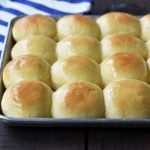The Best Homemade Dinner Rolls
Buttery, fluffy homemade dinner rolls are always a huge hit!
Servings: 20
Ingredients
- 1 1/2 Tablespoons Yeast
- 1/4 cup Warm Water
- 1 teaspoon Sugar
- 1/2 cup Butter softened
- 1/2 cup Sugar
- 3 Eggs
- 1 cup Whole or 2% Milk best warmed
- 4 3/4 cups Flour may need to add more
- 2 teaspoons Salt
- Brush on top of rolls:
- 4 - 8 Tablespoons Butter softened
Instructions
- In a small bowl, add yeast, warm water, and sugar and set aside to proof. Let the yeast bubble and foam for 10 minutes.
- In a stand mixer or large bowl, cream butter and sugar for 1 minute. Add eggs and milk and mix for 2 more minutes. Add in proofed yeast mixture.
- Pour in flour and salt. Mix for 5-7 minutes. Watch for the dough to start to come off the sides of the bowl. Add 1-3 Tablespoons of flour, if needed.
- Cover bowl and set aside to rise in a warm place until double in size, about 1-2 hours. If you want to expedite the rising process, heat the oven to 200 degrees, turn off the oven, and place the oven-safe bowl to rise until double in size.
- Once the dough is doubled, roll into small balls, about 16 - 20 depending on size preference. Place on greased or buttered baking sheet, close together to ensure the rolls rise upward and not spread, and brush rolls with softened butter. Cover and set aside to rise for 1 hour.
- Preheat oven to 350 degrees.
- Bake for 14 - 18 minutes or until golden brown. Brush rolls with remaining melted butter.
- Serve warm or store in air-tight container.
